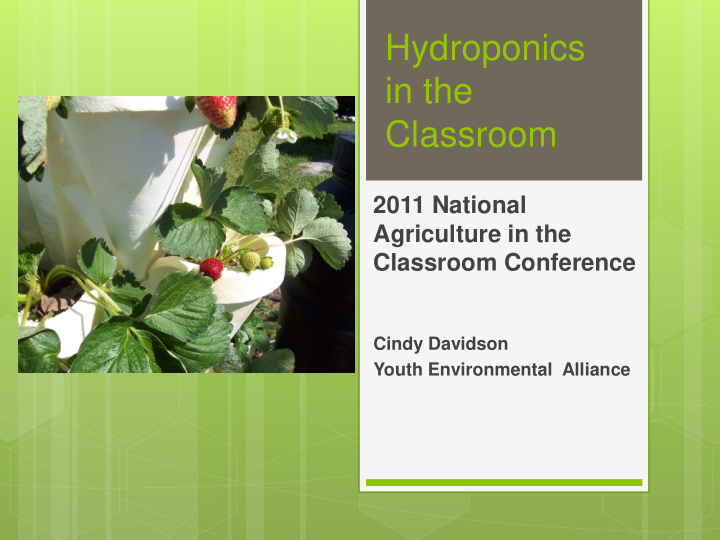



Hydroponics in the Classroom 2011 National Agriculture in the Classroom Conference Cindy Davidson Youth Environmental Alliance
What is hydroponics? The Greek word “hydro” means water and “ponos” means labor or work. Hydroponics is a method of growing plants in water without soil. The water must be enriched with nutrients and the plants need some type of inert medium to support the root system.
Many different civilizations have utilized hydroponic growing techniques throughout history. The floating gardens of the The hanging gardens of Babylon Aztecs of Mexico Egyptian hieroglyphic records dating back several hundred years B.C. describe the growing of plants in water.
Hydroponics Today Hydroponics is hardly a new method of growing plants. Throughout the last century, scientists and horticulturists have experimented with many different methods of hydroponics.
Plant Needs • Water • Nutrients • Light • Air • Structural Support
Plant Structure Flower Fruit Seed Shoot Leaf Stem Root Roots
Nutrients Basics Mineral nutrient elements are divided into 2 groups. MACRO nutrients Primary: Nitrogen (N) Phosphorous Potassium (K) (P) Secondary: Calcium (Ca) Magnesium Sulphur (S) (Mg) MICRO nutrients Iron (Fe) Boron (B) Zinc (Zn) Copper (Cu) Manganese Sodium (Na) Chlorine (Cl) Cobalt (Co) (Mo)
Feeding Plants • Commercial hydroponic fertilizers: Advantage-- excellent quality and reasonable cost. Disadvantage--difficult to find. • Specialty fertilizers from hydroponic shops: Advantage--good quality, many come in liquid form, and are available almost anywhere. Disadvantage-- expensive. • Water soluble fertilizer: Advantage--reasonable cost and good availability. Disadvantage--All have something in them that is not ideal for hydroponics.
pH
pH Va lue s F or Diffe re nt Hydroponic Crops (F r om Hydr oponic F ood Pr oduc tion by Howar d M. Re sh Woodbr idge Pr e ss, 1987) pH Ra ng e Pla nt 6.0-6.5 Be a ns 6.0-6.5 Broc c oli 6.5-7.5 Ca bba g e Ca nta loupe 6.5-6.8 Ca rrots 5.8-6.4 6.0-6.5 Chive s 5.8-6.0 Cuc umbe rs 6.0-6.5 Ga rlic 6.0-6.5 L e ttuc e 6.5-7.0 Onions 6.0-6.8 Pe a s 5.0-5.5 Pine a pple 5.0-6.5 Pumpkin 6.0-7.0 Ra dish 5.5-6.5 Stra wbe rrie s 5.5-6.5 T oma toe s
pH Testing Methods used to test pH: • Paper test strips • Liquid pH test kits • Digital meters Methods used to adjust pH: • phosphoric acid – lower pH • Potassium hydroxide – raise pH • Food grade citric acid • Vineger - lower pH • Baking soda – raise pH • Hydroponic pH adjusters
Types of Systems • Active • Passive • Media-based • Water culture
Media-based Systems Floating raft Ebb-and-flow
Water culture Systems
Growing Media Commonly used growing media for hydroponic culture: • Coconut Fiber • Expanded Clay • Perlite • Rockwool • Sand • Vermiculite
Light
Plants
Growing Plants can grow quickly using hydroponic methods. Keep a log of how your plants grow.
Why Teach Hydroponics? Hydroponics is applicable in many classrooms– from kindergarten to college. Here are just some subject matters that can be covered: • Biology: understanding photosynthesis, experiments with pH and nutrients, microbes and root development, light color spectrum effects, etc.
Why Teach Hydroponics? • Chemistry: Interaction of various nutrients, pH adjusting, calculating ppm of nutrients, etc. • History: Ancient history and hydroponics, scientific pioneers of hydroponics
Why Teach Hydroponics? • Math/Business : sell cuttings/seedlings for school project; calculate cost to produce and selling price. • Geography : Research plants from around the world • Engineering/Physics : system designs, capillary movement
Projects Sawgrass Springs Middle School Grow it Green Project
Projects Sawgrass Nature Center G.O.A.L. Project
Projects Coral Glades High School Seed to Table Project
Projects Hunt Elementary School Earth Patrols
Resources Kidsgardening.org http://www.kidsgardening.com/HYDROPONICSGUIDE/hydro1-1- intro.asp Growing Edge http://www.growingedge.com/basics/tutorial/01_history.html S.H.A.R.P. Lesson Plans for Hydroponics http://library.thinkquest.org/C0110342/lessonplan
Resources Supply sources: • Growers Supply • Sunlight Supply Inc. • Verti-Gro • HYDRO-STACKER • Home Depot
Table Top Hydroponic
Table Top Hydroponic
Contact Information Cindy Davidson Youth Environmental Alliance 954-649-7717 cindy@yeafrog.org
Recommend
More recommend